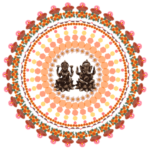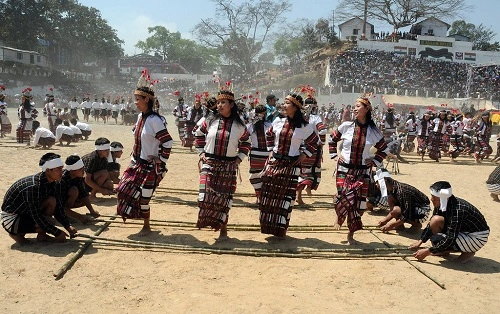The Cheraw dance originates from Mizoram, India, and is a traditional bamboo dance. It is thought to be among the state’s oldest dances, having originated in the 1st century.
Beautifully situated in northeastern India, Mizoram is a state with a rich cultural history. Of all the traditional arts that have flourished here for ages, the Cheraw Dance is one of the most important. Cheraw Dance is a beautiful folk dance that mixes rhythm, grace, and agility in a dazzling exhibition of cultural expression.
During the festival season, Mizoram’s dances are mostly performed. Most of these folk dances are performed in groups. Bamboo dance is the most common name for Cheraw dance. The dance gets its name because bamboos are engaged in its performance. Together, men and women perform the Mizoram bamboo dance.

The Mizo people, who are the native inhabitants of Mizoram, have a rich history and culture that are ingrained in Cheraw Dance. The bamboo sticks are thought to have represented the heavenly spirits when it first began as a kind of devotion and celebration in antiquity. With time, the dance has changed and developed into a vital component of Mizo rituals, festivals, and social events.
The Dance Performance:

The numbers of the Cheraw performers can vary, although they often dance in groups of six to eight. There are two bamboo staves on the ground, arranged horizontally. The male performers, paired off, each wield two bamboo staves and rhythmically clap them against the floor and each other. In the meantime, the female performers move in time with the beat, dancing and slicing between the bamboos.
Six to eight persons sit in front of each other in pairs and execute the dance. They arrange themselves horizontally or diagonally on the ground, holding bamboo staves. Dancers move in time with the beat of the drum, stepping in and out of the bamboo sticks.
It’s claimed that the dancing moves were influenced by motions found in nature, such as birds flying and trees swaying. The performers’ colorful clothing enhances the beauty of the dance, even if their quick and deft moves are breathtaking.

The dancer steps in and out of between two horizontal bamboos and across them alternately during the performance. These bamboos are held against the ground by most people seated with their backs to the walls. Sitting people tap the bamboos, opening and closing them in time with the rhythmic rhythms.
The bamboos are arranged horizontally, with one base supporting each end. A harsh sound is produced when bamboos move in tandem with clapping. The dance is timed to this specific sound. It also shows when to perform the dancing steps. To the beat of the bamboo, the dancers execute a variety of captivating dances in and out. The dance generally has a lot of beautiful changes in its rhythms and footwork.
Musical Instruments:
Traditional instruments including gongs, drums, cymbals, and the “Darbu,” a reed flute, are usually played by a group of musicians to accompany Cheraw Dancing. The charming atmosphere that the beautiful music creates elevates the dance experience as a whole. With their feet just barely touching the bamboo poles, the dancers decked out in vibrant traditional clothing, and moved with agility and precision, creating complex forms and patterns.
Costume of Cheraw Dance:
During the Cheraw dance, performers frequently wear the following costumes:
Women

Vakiria, a headdress for women fashioned from bamboo and embellished with feathers, beetle wings, and other vibrant elements, took on its current form during the 1960s.
Kawrchei: Black blouse, red, green, and white.
Puanchei: sarong in white, red, green, and black.
Men
Khumbeu: Mizo Shawl with a bamboo cap.
The vivid colors of each of these Cheraw Dancing traditional outfits enhance the surrounding scene.
Short Story About Cheraw Dance:

The history and customs of the Mizo people, the native residents of Mizoram, are fundamental to the Cheraw Dance. It is thought to have started off as a worship and celebration ritual in the past, with the bamboo sticks standing in for the heavenly spirits.
During {Buhza Aih}, the bumper harvest, a single family celebrates by dancing the Cheraw. It’s basically a dance that a chosen group of girls with exceptional talent perform, rather than a dance that the community participates in. In addition, it is done during marriage ceremonies and during celebrations of achievement. On such occasions, a large crowd comes to see the few talented dancers perform the {Cheraw} dance with pride.
The Mizos’ joyful disposition and excitement are genuinely conveyed through their dances. The gong and the drum are two examples of Mizo traditional musical instruments. The Mizo people’s Bamboo Dance is regarded as their most vibrant and unique dance.
Cultural Recognition:

Cheraw is becoming more and more well-known worldwide. The dance style was listed in the Guinness Book of World Records in 2010. For eight minutes, ten thousand seven hundred and sixty-three people danced in unison, creating the largest dance ensemble in history. on Aizawl, the capital city of Mizoram, around 8,000 dancers performed over a three-kilometer stretch of road, although only about 2,000 could fit on the Assam Rifles field.
Cheraw Dance faces the problem of maintaining its authenticity and relevance in the contemporary period, much like any other traditional art form. The Mizo community, cultural institutions, and the government are working to preserve and advance this priceless art form. To make sure that the next generation is aware of and appreciates its cultural heritage, Cheraw Dance workshops, performances, and festivals are periodically arranged.
Conclution:
Finding that Cheraw is gradually receiving the credit it deserves is heartening. It has become more well-known outside of Mizoram in recent years, enthralling viewers everywhere. People from a variety of backgrounds have expressed admiration and enthusiasm for the dance’s captivating footwork, rhythmic beats, and deep cultural roots. It acts as a link between many cultural contexts, promoting awareness of and respect for Mizoram’s rich past.
Cheraw Dancing is evidence of Mizoram’s rich cultural legacy. Its alluring beauty, profound meaning, and graceful rhythm continue to enthrall listeners inside and outside of the state. The Mizo people honor their ancestors and give the world a glimpse of their lively culture by maintaining and advancing this traditional art form. The Mizo people’s energy, tenacity, and dedication to maintaining their cultural identity are embodied in the magnificent Cheraw Dance.

